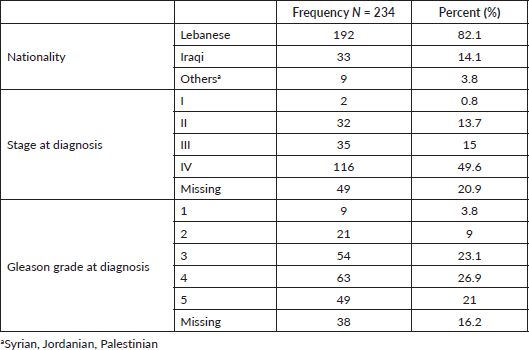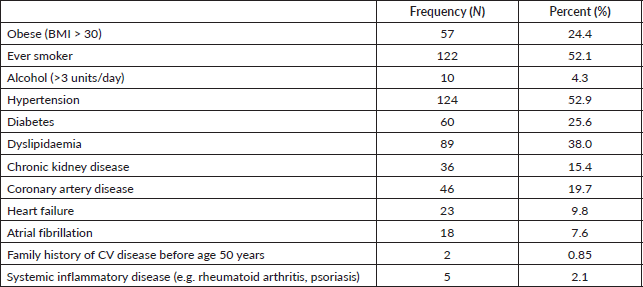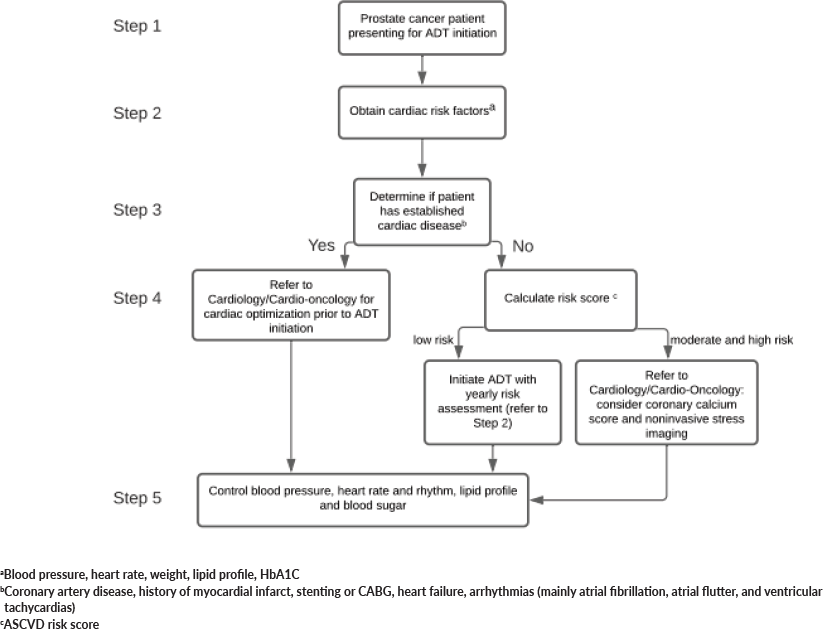Cardiac risk factors and events in patients with prostate cancer commencing androgen deprivation therapy: analysis from a tertiary care centre in the Middle East
Mona Ali Hassan1, Talar Telvizian2, Mostafa Abohelwa3, Deborah Mukherji1 and Hadi Skouri4
1Division of Hematology/Oncology, American University of Beirut Medical Center, Beirut 1107 2020, Lebanon
2Department of Internal Medicine, Lankenau Medical Center, Wynnewood, PA 19096, USA
3Department of Internal Medicine, Texas Tech University Health Science Center, Lubbock, TX 79430, USA
4Division of Cardiology, American University of Beirut Medical Center, Beirut 1107 2020, Lebanon
Abstract
Background: Androgen deprivation therapy (ADT) is the mainstay of treatment for advanced prostate cancer, improving symptoms and prolonging survival. There is an association between ADT use and cardiovascular (CV) events, particularly in patients with preexisting risk factors. In men diagnosed with prostate cancer, CV disease is the principal non-cancer-related cause of death. There are no definite guidelines to stratify patients based on CV risk prior to ADT initiation. This is the first study on cardiac risks and events in patients with prostate cancer treated with ADT from the Middle East region, a population known to have a high prevalence of CV risk factors.
Results: A retrospective study of 234 patients with prostate cancer, who received ADT therapy at a tertiary care centre in Lebanon was conducted. CV risk factors at baseline and CV events on ADT were reviewed. The median age was 68 years (48–92 years). The majority of patients had stage 4 diseases at diagnosis (49.6%) with a median duration of 12 months on ADT. In our cohort, 24.4% had body mass index > 30, 52.1% had smoking history, 25.6% were diabetic, 19.7% had history of coronary artery disease, 9.8% had heart failure history and 52.9% had hypertension. Less than half of the patients had a documented lipid profile at baseline. Twenty-two patients (9.5%) had documented cardiac events following ADT initiation.
Conclusions: In this cohort of patients from the Middle East, we found that one third of the population had established coronary artery disease at baseline and 9.5% had documented cardiac events on ADT initiation. Our study highlights the gaps in CV risk assessment for this high-risk group of patients with prostate cancer in addition to high prevalence of CV comorbidities. Risk and resource-stratified algorithms are needed before starting ADT therapy for optimal CV health. Increased awareness, collaboration and referral mechanisms between oncologists, urologists and cardiologists are also needed to provide optimal care.
Keywords: androgen deprivation therapy, ADT, cardiovascular risk factors, cardiovascular events, Middle East, prostate cancer
Correspondence to: Hadi Skouri
Email: hs13@aub.edu.lb
Published: 14/09/2022
Received: 11/05/2022
Publication costs for this article were supported by ecancer (UK Charity number 1176307).
Copyright: © the authors; licensee ecancermedicalscience. This is an Open Access article distributed under the terms of the Creative Commons Attribution License (http://creativecommons.org/licenses/by/4.0), which permits unrestricted use, distribution, and reproduction in any medium, provided the original work is properly cited.
Background
Prostate cancer is the most common cancer affecting men worldwide with an average age of 67 years at diagnosis [1]. Androgen Deprivation Therapy (ADT) is the cornerstone of treatment for advanced stages of prostate cancer and is also used for localised disease in combination with radiation therapy [2].
Despite the fact that ADT prolongs survival in advanced prostate cancer, several studies have indicated that men receiving ADT are at increased risk of fatal and nonfatal cardiovascular (CV) events [3]. This risk is particularly high in men with CV risk factors or previous CV events [4, 5]. So far, there are no specific guidelines for baseline CV risk stratification of patients diagnosed with prostate cancer prior to initiation of ADT. Men in the Middle East have a high prevalence of CV disease [6] and data suggest that a high proportion of men diagnosed with prostate cancer in the region present with advanced disease at diagnosis, necessitating the long-term use of ADT [7]. Our study is the first to evaluate cardiac risks and events in patients on ADT from Lebanon and the Middle East, a population known to have a high prevalence of CV risk factors and our main objective is to look at the baseline characteristics of our cohort and the incidence of CVS among them.
Methods
Following Institutional Review Board approval, data were collected through a retrospective chart review of all patients with prostate cancer, who were initiated on ADT from 2014 to 2019 at the American University of Beirut Medical Center. The parameters collected include: prior symptomatic coronary artery disease including carotid artery disease or peripheral artery disease (e.g. stable angina, acute myocardial infarction, transient ischaemic attacks, stroke, ischaemic claudication), age, gender, height, weight, smoking status (current, ex- or non-smoker), history of chronic kidney disease, history of systemic inflammatory disease (e.g. rheumatoid arthritis, psoriasis), family history of premature CV disease (before age 60 years). In addition, the following parameters pre and post ADT initiation were collected: lipid profile, diabetes mellitus, cardiac arrhythmia, heart failure and the development of cardiac events and death on ADT therapy.
Statistical analysis was performed using SPSS version 25. Descriptive analysis was performed for age, cancer stage, CV risk factors and ADT duration. The prevalence of CV risk factors at baseline and CV events while on ADT therapy was analysed through basic percentage calculation.
Results
In our cohort, 234 patients received ADT for prostate cancer as a part of their treatment plan over the period studied. The median age at diagnosis was 68 with a range of 48–92 years. The majority of patients had stage 4 disease at diagnosis (49.6%) with a median duration of 12 months on ADT. Regarding initial ADT, 17 patients had surgical castration with orchiectomy while the remainder had luteinising hormone-releasing hormone agonist or antagonist. Two patients did not have any documentation about the type of hormonal treatment. Baseline demographic factors and prostate cancer characteristics are included in Table 1, where 142 patients (60.7%) had all the factors documented in the chart. Table 2 demonstrates the baseline CV risk factors, and only 84 patients (35.9%) had a full set of data.
Only 95 patients (40.6%) before ADT and 98 patients (41.8%) after ADT had a lipid profile documented in their chart. The mean values before and after ADT, respectively, were: total cholesterol (174.4 and 179.4 mg/dL), LDL (107.6 and 113.4 mg/dL) and HDL (44.2 and 45.4 mg/dL).
Table 3 highlights the incidence of cardiac risk factors after ADT initiation, the most common diagnosis being dyslipidaemia (11.5%) followed by arrhythmias (10.7%). After ADT initiation, 22 patients (9.4%) had a documented CV event including acute myocardial infarction, acute coronary syndrome or stroke. Eight patients (3.4%) underwent percutaneous coronary intervention or coronary artery bypass grafting during hormonal treatment. Overall, 32 patients (9.8%) were documented to have died during treatment.
Discussion
The association between ADT and CV events was first demonstrated in 2006 when Keating et al [8] conducted a study of over 73,000 Medicare patients with localised prostate cancer which showed increase in the incidence of sudden cardiac death, coronary heart disease, myocardial infarction and diabetes among 36% of men on GnRH agonists. The mechanism by which ADT is thought to increase CV risk is by decreasing insulin sensitivity and promoting dyslipidaemia and obesity, thus leading to an increased risk of CV morbidity and mortality [9].
Table 1. Patient nationalities and disease stage at time of diagnosis.

Table 2. Baseline CV risk factors.

The Middle Eastern population in general, and Lebanon in particular, is a population that is known for high incidence of CV events occurring in around 13.7% of the overall population [10]. A study conducted in 2010 showed that ischaemic heart disease was the leading cause of death in Lebanon (32.2%) [11].
In our study, we found that one third of the population had established coronary artery disease at baseline and 9.5% had documented cardiac events on ADT initiation and, in this cohort of patients, the median age was 68 years (48–92 years). The majority of patients had stage 4 disease at diagnosis (49.6%) with a median duration of 12 months on ADT. In our cohort, 24.4% had body mass index > 30, 52.1% had smoking history, 25.6% were diabetic, 19.7% had history of coronary artery disease, 9.8% had heart failure history and 52.9% had hypertension. Less than half of the patients had a documented lipid profile at baseline. Twenty two patients (9.5%) had documented cardiac events following ADT initiation.
Recently, the Cardio‐Oncology Study Group of the Heart Failure Association of the European Society of Cardiology in collaboration with the International Cardio‐Oncology Society has published the baseline CV risk stratification in oncology patients receiving cancer therapies. They highlighted the role of risk stratification in prostate cancer patients receiving or need to be initiated on ADTs [12]. Their risk stratification pro forma will divide the patients into high, medium and low risk depending on the presence of preexisting CV disease or on the CV disease 10-year risk score. It was suggested that any of the following risk scores can be used: ESC Heart Score, QRISK, ACC/AHA pooled cohort CV risk calculator or JBS3 risk score. There are essential risk factors and variables that are required on screening prior to initiation of ADT and to help calculate CV risk score. These variables need to be obtained in either the urology or oncology clinic so the risk score can be estimated. Variables needed include: age, gender, ethnic group, height, weight, social class indicator, smoking status (current, ex- or non-smoker), total cholesterol, high-density lipoprotein cholesterol, systolic blood pressure (mmHg), diabetes status, family history of premature CV disease (before 60 years), chronic kidney disease, atrial fibrillation, systemic inflammatory disease (e.g. rheumatoid arthritis, psoriasis). The importance of preventive cardio oncology is rapidly evolving recently especially with multi-modality risk prediction strategies, moving towards precision surveillance and interventions that allow for safe continuation of life-saving chemotherapy [13].
Initially we intended to calculate the atherosclerotic cardiovascular disease risk (ASCVD) score of all patients to stratify them into low, borderline, medium and high risk, but most of the patients did not have any documented lipid profile at baseline before ADT initiation and this was particularly noticed among patients who were followed up by urologist rather than those who were followed up by an oncologist. This is why it is essential to have a unified algorithm among all specialities taking care of these patients to prevent CV complication during long-term therapy.
We are suggesting an algorithm (see Figure 1) for CV risk stratification of prostate cancer patients before ADT initiation, as outlined in Figure 1. ADT for prostate cancer patients is usually a long-term therapy and patients would benefit from counselling about CV effects, baseline risk assessment and timely referral to a cardiologist for the management of their cardiac risk factors and/or diseases.
The limitation of our study lies mainly in the small sample size and missing data in the charts. It is important to note that patients were followed by one or more different speciality physicians including oncologists, urologists, radiation oncologists and cardiologists which likely contributed to missing and decentralised data Also, one of the limitations is that we were not able to do regression analyses (Cox) to look at potential confounders as well as stratified analyses based on the risk factors identified at baseline.
Table 3. Incidence of cardiac risk factors after ADT initiation.


Figure 1. Proposed algorithm for CV risk stratification of prostate cancer patients before ADT initiation.
Conclusions
This is the first study on cardiac risks and events in patients on ADT from Lebanon and the Middle East region, a population which is known to have a high prevalence of CV risk factors. In this cohort of patients from the Middle East, we found that one third of the population had established coronary artery disease at baseline and 9.5% had documented cardiac events with a significant percentage with CV risk factors on ADT initiation. Our study highlights the gaps in CV risk assessment for this high-risk group of patients with prostate cancer. Risk and resource-stratified algorithms are needed before starting ADT therapy for optimal CV health. Increased awareness, collaboration and referral mechanisms between oncologists, urologist and cardiologists are also needed to optimise patient care.
List of abbreviations
ADT, Androgen deprivation therapy; CV, Cardiovascular.
Declarations
None.
Ethical approval and consent to participate
Institutional Review Board approval was obtained.
Consent for publication
NA.
Availability of data and material
Data is available upon request.
Conflicts of interest
DM: Research funding from Astellas, honoraria/travel support from Astellas, Janssen, Bayer, Sanofi.
All other authors: none.
Funding
None.
Authors’ contributions
DM and HS: conception and design, supervision
TT: data collection, analysis and results, manuscript writing
MH: data collection, manuscript writing
MA: data collection, manuscript writing.
Acknowledgments
None.
References
1. SEER cancer stat facts: prostate cancer Bethesda: National Cancer Institute [https://seer.cancer.gov/statfacts/html/prost.html2021]
2. Cooperberg MR, Lubeck DP, and Meng MV, et al (2004) The changing face of low-risk prostate cancer: trends in clinical presentation and primary management J Clin Oncol 22(11) 2141–2149 https://doi.org/10.1200/JCO.2004.10.062 PMID: 15169800 PMCID: 2997214
3. Higano CS (2020) Cardiovascular disease and androgen axis-targeted drugs for prostate cancer N Engl J Med 382(23) 2257–2259 https://doi.org/10.1056/NEJMe2016433 PMID: 32469186
4. Van Hemelrijck M, Garmo H, and Holmberg L, et al (2012) Multiple events of fractures and cardiovascular and thromboembolic disease following prostate cancer diagnosis: results from the population-based PCBaSe Sweden Eur Urol 61(4) 690–700 https://doi.org/10.1016/j.eururo.2011.09.010
5. Smith MR, Lee H, and McGovern F, et al (2008) Metabolic changes during gonadotropin-releasing hormone agonist therapy for prostate cancer: differences from the classic metabolic syndrome Cancer 112(10) 2188–2194 https://doi.org/10.1002/cncr.23440 PMID: 18348297 PMCID: 2562782
6. Govender RD, Al-Shamsi S, and Soteriades ES, et al (2019) Incidence and risk factors for recurrent cardiovascular disease in middle-eastern adults: a retrospective study BMC Cardiovasc Disord 19(1) 253 https://doi.org/10.1186/s12872-019-1231-z PMID: 31711429 PMCID: 6849175
7. Daher M, Telvizian T, and Dagher C, et al (2021) High rates of advanced prostate cancer in the middle east: analysis from a tertiary care center Urol Ann 13(4) 418–423 https://doi.org/10.4103/UA.UA_47_20 PMID: 34759656 PMCID: 8525480
8. Keating NL, O’Malley AJ, and Smith MR (2006) Diabetes and cardiovascular disease during androgen deprivation therapy for prostate cancer J Clin Oncol 24(27) 4448–4456 https://doi.org/10.1200/JCO.2006.06.2497 PMID: 16983113
9. Gupta D, Lee Chuy K, and Yang JC, et al (2018) Cardiovascular and metabolic effects of androgen-deprivation therapy for prostate cancer J Oncol Pract 14(10) 580–587 https://doi.org/10.1200/JOP.18.00178 PMID: 30312560
10. Shehab A and Bhagavathula AS (2019) P5317 Prevalence of cardiovascular diseases in the middle-east: systemic review and meta-analysis Eur Heart J 40 3215 https://doi.org/10.1093/eurheartj/ehz746.0287
11. Fahs I, Khalife Z, and Malaeb D, et al (2017) The prevalence and awareness of cardiovascular diseases risk factors among the Lebanese population: a prospective study comparing urban to rural populations Cardiol Res Pract 2017 3530902 https://doi.org/10.1155/2017/3530902 PMID: 28465858 PMCID: 5390633
12. Lyon AR, Dent S, and Stanway S, et al (2020) Baseline cardiovascular risk assessment in cancer patients scheduled to receive cardiotoxic cancer therapies: a position statement and new risk assessment tools from the Cardio‐Oncology Study Group of the Heart Failure Association of the European Society of Cardiology in collaboration with the International Cardio‐Oncology Society Eur J Heart Fail 22 1945–1960 https://doi.org/10.1002/ejhf.1920 PMID: 32463967 PMCID: 8019326
13. Iacopo F, Branch M, and Cardinale D, et al (2021) Preventive cardio-oncology: cardiovascular disease prevention in cancer patients and survivors Curr Treat Options Cardio Med 23(1) 8 https://doi.org/10.1007/s11936-020-00883-1






